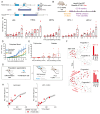A time- and single-cell-resolved model of murine bone marrow hematopoiesis
- PMID: 38183977
- PMCID: PMC7615671
- DOI: 10.1016/j.stem.2023.12.001
A time- and single-cell-resolved model of murine bone marrow hematopoiesis
Abstract
The paradigmatic hematopoietic tree model is increasingly recognized to be limited, as it is based on heterogeneous populations largely defined by non-homeostatic assays testing cell fate potentials. Here, we combine persistent labeling with time-series single-cell RNA sequencing to build a real-time, quantitative model of in vivo tissue dynamics for murine bone marrow hematopoiesis. We couple cascading single-cell expression patterns with dynamic changes in differentiation and growth speeds. The resulting explicit linkage between molecular states and cellular behavior reveals widely varying self-renewal and differentiation properties across distinct lineages. Transplanted stem cells show strong acceleration of differentiation at specific stages of erythroid and neutrophil production, illustrating how the model can quantify the impact of perturbations. Our reconstruction of dynamic behavior from snapshot measurements is akin to how a kinetoscope allows sequential images to merge into a movie. We posit that this approach is generally applicable to understanding tissue-scale dynamics at high resolution.
Keywords: Hoxb5; differentiation rate; dynamics; hematopoiesis; modeling; progenitors; scRNA-seq; self-renewal; stem cells.
Copyright © 2023 The Author(s). Published by Elsevier Inc. All rights reserved.
Conflict of interest statement
Declaration of interests N.B. is now an employee of AstraZeneca. I.K. is now an employee of Xap Therapeutics.
Figures






References
Publication types
MeSH terms
Grants and funding
LinkOut - more resources
Full Text Sources
Medical
Molecular Biology Databases

